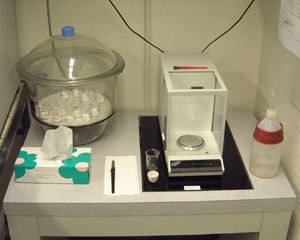
This is where we weigh mixtures of sample powder (after determination of L.O.I.)
with dilithiumtetraborate for fusion. The tools one needs are shown
(Kimwipes, powder spatula, ignited sample in ceramic crucible, clean glass beaker, acetone, dessicator, scale with cleaning brush).
Never switch the scale off, also not overnight or on weekends. The weighing will also be much more stable. If the indicated masses seem unstable, recalibrate the scale as follows:
The casting powder is a homogenous mixture of the sample powder dehydrated by ignition and a flux (Li2B4O7 = di-lithium tetraborate). The flux lowers the melting point of the mixture far enough, so that the powder easily melts at ca. 1150°C and can be casted.
It is best to perform the L.O.I. procedure (for instructions, see here) in combination with the powder preparation. We usually work in a flow-through scheme of placing new samples in the oven for L.O.I. determination while taking others out for weighing and powder preparation.
1.5 g of the sample powder dehydrated by ignition is to be weighed on weighing paper or in a small glass beaker. Then 7.5 g di-lithium tetraborate are added. These masses have to be accurate by four digits (1.0000 g). This ensures an exact mixture of 5 : 1 (flux : powder), necessary for calibration to the internal standard Li.
The powder is transferred quantitatively into an agate mortar and homogenized with the pestle. Coarser grains of the ignition-dehydrated powder will also be ground in this process. Homogenisation is necessary because the agitation in the furnace alone still results into measurable inhomogeneities and thus to larger analytical errors. As long as the powder is not absolutely homogenous, any spilling of powder over the mortar rim will alter the analytical result.
The powder mixture has to be transferred quantitatively into the Ti crucible after homogenisation. Please ensure that no powder is on the flat rim of the crucible. Remove with towel or rubber spatula - the powder can interfere with the casting.
If you plan to leave for longer than a few hours, we suggest you keep the mixtures (covered with Parafilm or a watch glass) in the desiccator.
or: